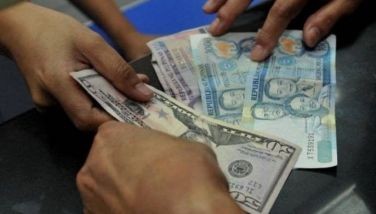Foreign chambers: RP can attract $8.5-billion investments if…
October 6, 2006 | 12:00am
$8.5 billion a year over the next four years.
But whether or not this potential could be realized would depend on the country’s political stability and the government’s ability to address critical concerns of foreign investors.
The foreign chambers of commerce led by the American Chamber of Commerce and Industry (AmCham) reported that the country could attract foreign direct investments of up to $34 billion over the next four years.
During the workshop on attracting foreign direct investments, foreign companies operating in the Philippines stressed that there is significant potential in the mining, power, energy, information technology, health, manufacturing and infrastructure industries.
Ford Philippines president and AmCham vice president Henry Co said after the workshop that the estimated $8.5 billion worth of foreign direct investments can generate up to a million new jobs a year.
However, realizing this potential would depend on whether constraints to investments could be addressed, such as political stability, transparency, graft and corruption. Also to be factored in is the government’s willingness to protect and uphold the sanctity of awarded contracts, especially in big-ticket utilities and infrastructure projects.
Expectations are high but actual foreign direct investments to the country are not as big. The Bangko Sentral ng Pilipinas (BSP) has estimated that for 2006, total foreign direct investments to the country would reach close to $2 billion.
Iluminada Sicat, who heads the BSP’s Department of Economic Statistics (DES), revealed that only about 60 to 70 percent of planned foreign direct investments end up being registered as actual investments.
"There are a lot of factors that determine whether intentions are translated into actual investments," Sicat said. "Political certainty and stability is a big concern."
Foreign investors in the country were, however, optimistic that under ideal conditions — where their primary concerns are addressed — the Philippines has the potential to attract foreign investments that would otherwise go to other countries.
In the energy sector alone, GNPower president and Amcham energy committee co-chairman Daniel Chalmers said that up to $14 billion worth of foreign direct investments could be generated and bring in 100,000 new jobs.
But Chalmers said this would depend on how fast the government can privatize government-owned power generation companies and transmission companies.
He said energy and power companies should also shift their strategy towards more creative financing alternatives since the government has stopped granting sovereign guarantees on borrowed funds.
"We can’t march into the room demanding sovereign guarantees anymore," Chalmers said. "We have to move away from traditional thinking on the financing of power projects. We can look at bilateral contracts, for example."
The mining sector was estimated to attract up to $5 billion but only if the government would "unwaveringly implement" the mining law.
In the information technology sector, foreign investors warned that although the industry was growing fast, it should not be considered the silver bullet that would solve the country’s problems.
According to Frank Holz, chief executive officer of Outsource2Philippines and co-chairman of the AmCham ICT committee, the IT industry could realistically generate up to $3 billion worth of foreign direct investments in the next four years, or optimistically up to $3.45 billion.
Holz cautioned that the estimate was largely based on "anecdotal" average cost per seat in the IT industry but there is potential, especially if the English proficiency of the workforce would be improved.
"Remember that five years ago, there were maybe five countries doing this," Holz said. "Now there are over 40 countries competing with each other."
Holz added that the government needed to improve the educational system to make the curriculum more technical and to take pro-active steps that would give the workforce the education that would guarantee jobs in the country. — With Marianne Go, Paolo Romero
But whether or not this potential could be realized would depend on the country’s political stability and the government’s ability to address critical concerns of foreign investors.
The foreign chambers of commerce led by the American Chamber of Commerce and Industry (AmCham) reported that the country could attract foreign direct investments of up to $34 billion over the next four years.
During the workshop on attracting foreign direct investments, foreign companies operating in the Philippines stressed that there is significant potential in the mining, power, energy, information technology, health, manufacturing and infrastructure industries.
Ford Philippines president and AmCham vice president Henry Co said after the workshop that the estimated $8.5 billion worth of foreign direct investments can generate up to a million new jobs a year.
However, realizing this potential would depend on whether constraints to investments could be addressed, such as political stability, transparency, graft and corruption. Also to be factored in is the government’s willingness to protect and uphold the sanctity of awarded contracts, especially in big-ticket utilities and infrastructure projects.
Expectations are high but actual foreign direct investments to the country are not as big. The Bangko Sentral ng Pilipinas (BSP) has estimated that for 2006, total foreign direct investments to the country would reach close to $2 billion.
Iluminada Sicat, who heads the BSP’s Department of Economic Statistics (DES), revealed that only about 60 to 70 percent of planned foreign direct investments end up being registered as actual investments.
"There are a lot of factors that determine whether intentions are translated into actual investments," Sicat said. "Political certainty and stability is a big concern."
Foreign investors in the country were, however, optimistic that under ideal conditions — where their primary concerns are addressed — the Philippines has the potential to attract foreign investments that would otherwise go to other countries.
In the energy sector alone, GNPower president and Amcham energy committee co-chairman Daniel Chalmers said that up to $14 billion worth of foreign direct investments could be generated and bring in 100,000 new jobs.
But Chalmers said this would depend on how fast the government can privatize government-owned power generation companies and transmission companies.
He said energy and power companies should also shift their strategy towards more creative financing alternatives since the government has stopped granting sovereign guarantees on borrowed funds.
"We can’t march into the room demanding sovereign guarantees anymore," Chalmers said. "We have to move away from traditional thinking on the financing of power projects. We can look at bilateral contracts, for example."
The mining sector was estimated to attract up to $5 billion but only if the government would "unwaveringly implement" the mining law.
In the information technology sector, foreign investors warned that although the industry was growing fast, it should not be considered the silver bullet that would solve the country’s problems.
According to Frank Holz, chief executive officer of Outsource2Philippines and co-chairman of the AmCham ICT committee, the IT industry could realistically generate up to $3 billion worth of foreign direct investments in the next four years, or optimistically up to $3.45 billion.
Holz cautioned that the estimate was largely based on "anecdotal" average cost per seat in the IT industry but there is potential, especially if the English proficiency of the workforce would be improved.
"Remember that five years ago, there were maybe five countries doing this," Holz said. "Now there are over 40 countries competing with each other."
Holz added that the government needed to improve the educational system to make the curriculum more technical and to take pro-active steps that would give the workforce the education that would guarantee jobs in the country. — With Marianne Go, Paolo Romero
BrandSpace Articles
<
>
- Latest
- Trending
Trending
Latest
Trending
Latest
Recommended
































